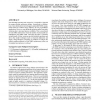Free Online Productivity Tools
i2Speak
i2Symbol
i2OCR
iTex2Img
iWeb2Print
iWeb2Shot
i2Type
iPdf2Split
iPdf2Merge
i2Bopomofo
i2Arabic
i2Style
i2Image
i2PDF
iLatex2Rtf
Sci2ools
DAC
2012
ACM
2012
ACM
Process variation in near-threshold wide SIMD architectures
Near-threshold operation has emerged as a competitive approach for energy-efficient architecture design. In particular, a combination of near-threshold circuit techniques and parallel SIMD computations achieves excellent energy efficiency for easy-to-parallelize applications. However, near-threshold operations suffer from delay variations due to increased process variability. This is exacerbated in wide SIMD architectures where the number of critical paths are multiplied by the SIMD width. This paper provides a systematic in-depth study of delay variations in near-threshold operations and shows that simple techniques such as structural duplication and supply voltage/frequency margining are sufficient to mitigate the timing variation problems in wide SIMD architectures at the cost of marginal area and power overhead. Categories and Subject Descriptors
Related Content
| Added | 29 Sep 2012 |
| Updated | 29 Sep 2012 |
| Type | Journal |
| Year | 2012 |
| Where | DAC |
| Authors | Sangwon Seo, Ronald G. Dreslinski, Mark Woh, Yongjun Park, Chaitali Chakrabarti, Scott A. Mahlke, David Blaauw, Trevor N. Mudge |
Comments (0)

